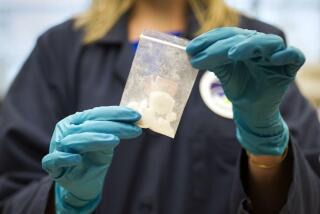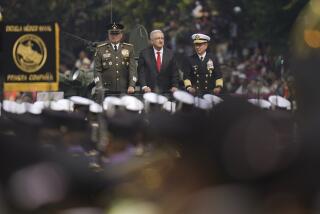Anti-Drug Forces Turn Attention to Venezuela : Crime: The country, long a center for laundering traffickers’ money, has become a major transshipment point for cocaine.
CARACAS, Venezuela — Two years ago, when President Bush was preparing to meet with Andean nation leaders at an anti-drug summit in Cartagena, Colombia, nobody thought about inviting Venezuela.
Although this South American country had long been a center for laundering drug traffickers’ illicit earnings, the 1989 Cartagena summit focused more on cocaine barons’ production bases--Colombia, Bolivia and Peru.
Now, few anti-narcotics experts are overlooking Venezuela, represented along with its Andean neighbors and Mexico at last month’s “Cartagena II” summit in San Antonio.
Officials say that in recent months this country has become both a major operations center for the cocaine trade and a symbol of the widening international drug battlefield.
Colombian traffickers in alliance with a Mafia of Venezuelans and Sicilians have so expanded their operations here in recent months that U.S. authorities are now calling Venezuela the most important transshipment point for Colombian cocaine. Many anti-narcotics officials say the surge in trafficking activity has caught Venezuelan authorities flat-footed despite President Carlos Andres Perez’s vocal commitment to the anti-drug fight.
“Traffickers feel real secure here right now,” said one international anti-narcotics official, who asked not to be named. Added Michael Skol, the U.S. ambassador to Venezuela, “The Venezuelan government is still coming to terms with the notion that drug trafficking is a major problem here.”
Anti-narcotics officials estimate that the amount of the drug traveling through the country is skyrocketing, from a rate of about 80 tons per year in 1989 to a high of 500 tons this year, about half of it destined for the United States and Europe.
The estimates are based on increased seizures both here and abroad. In previous years, U.S. authorities were confiscating no more than a few tons of cocaine shipped through Venezuela. That situation has changed drastically in recent months--more than 20 tons of Venezuelan-shipped cocaine were seized in the United States in December and January alone.
Venezuela was the transshipment point for the 12 tons of cocaine confiscated late last year by Miami authorities in the second-biggest cocaine seizure in one place in history. Evidence obtained by anti-narcotics agents now indicates that the cocaine came from a cartel based in the southern Colombian city of Cali.
Colombian cartel members and Venezuelan traffickers are facilitating their business by paying money for political influence in major cities and buying large stretches of jungle property along the 1,300 miles of border between the two countries, officials say.
“These criminals have the backing of important political leaders,” said Luis Hernandez, a Venezuelan congressman and former vice president of the Chamber of Deputies’ anti-drug commission. “They exercise influence over the state’s legal and financial institutions.”
Illicit narcotics activities are not altogether new in Venezuela, a country that two Sicilian-organized crime families, the Cuntreras and the Caruanans, have used as a base for smuggling Middle Eastern heroin since the 1970s. Hernandez and others say the families own hundreds of legitimate businesses in this country and have helped finance major political campaigns.
Even more disconcerting, according to anti-drug experts, is the Sicilians’ apparent alliance with Colombian traffickers who are moving into the heroin trade.
Last month, Colombian police began using aerial spraying of chemicals to try to eradicate thousands of acres of opium poppies, the raw material for heroin. Police recently denounced the illegal entry into Colombia of at least 50 Pakistanis, Indians and Sri Lankans, all suspected of helping teach the cartels there how to process heroin.
“This spurt of activity in Colombia is the best evidence of a new alliance between the Italian and Colombian Mafias,” said John Sweeny, a Caracas-based economist who has written extensively on the narcotics trade. “There is no way that the Sicilians would allow the Colombians to get into heroin without some sort of prior agreement. We would be seeing an all-out war right now.”
Instead, there is a quiet but steady flow of drugs from Colombia across the porous border into Venezuela. U.S. anti-drug officials have already detected cocaine laboratories on the Venezuelan side and have received intelligence that heroin laboratories are being set up.
The country’s National Guard recently raided a small, apparently experimental poppy cultivation site in Picoporo National Park, near the Venezuelan border city of San Cristobal. A retired senior military official with knowledge of the area said the crop destroyed there represents just a tiny portion of the poppies being grown in the region.
Venezuela’s narcotics problem is likely to continue expanding as Colombian police keep pressure on their nation’s traffickers, forcing them to seek havens elsewhere.
Hernandez said, for example, that thousands of acres of land near the town of El Vigia in the foothills of Venezuela’s Merida state have been bought by a brother-in-law of three Ochoa brothers, accused Medellin Cartel leaders currently awaiting trial after surrendering to Colombian authorities.
“The Medellin Cartel is alive and well in Venezuela,” the congressman added.
Colombian traffickers have also set up bases of operations in the northwest city of Maracaibo, the western states of Tachira and Falcon and the southern Amazon region, officials say.
But the hub of cocaine transport and storage is still the border region, where traffickers, arms merchants and other criminals move back and forth unimpeded.
“The border area is a no man’s land where people are neither Colombians nor Venezuelans, but change according to what suits them at a certain time,” said a senior Venezuelan official in Caracas. He added that much of the land in the area is controlled by former military and police commanders who help provide a safe corridor for cocaine.
Officials say that traffickers are continuing to pour their drug profits into Venezuela, a country with no statutes against money laundering. Millions of dirty dollars have been invested in real estate, travel agencies, currency exchanges, hotels and casinos.
“The problem is hard to measure, but there is no doubt that it’s growing worse,” said a U.S. official in Caracas.
The Perez government has made several moves to try to curb the narcotics trade, including increasing the budget for the Cabinet-level National Commission Against the Illicit Use of Drugs from last year’s $500,000 to this year’s $10 million.
The director of the commission, Enrique Rivas Gomez, said that much of the money would go into treating the country’s growing number of addicts to basuco, a raw form of cocaine. He added, however, that efforts would also be made to increase domestic interdiction of cocaine. Seizures in Venezuela rose from six tons in 1990 to nine tons in 1991.
U.S. officials say that certain Colombian security forces, such as the National Guard, have shown great zeal in going after drug traffickers. But they criticize Venezuela’s lack of a unified anti-narcotics force like that of the Colombian police.
“I agree that such a force is needed in Venezuela, and we are pressing the Congress to approve legislation allowing it,” Rivas said.
He and others maintain that the United States must increase its support for Venezuelan anti-drug efforts if the country is to make any headway. U.S. anti-drug aid to Venezuela has remained constant for the last three years at about $800,000.
More to Read
Sign up for Essential California
The most important California stories and recommendations in your inbox every morning.
You may occasionally receive promotional content from the Los Angeles Times.










